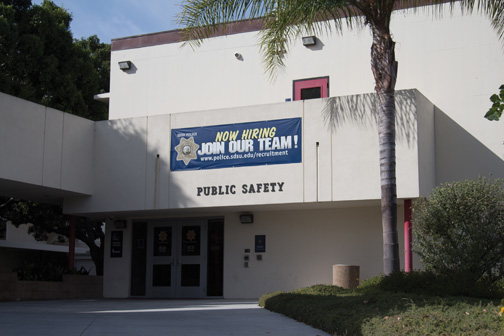Facial recognition technology, previously limited to soldiers in Afghanistan and FBI agents, is now being used by civilian law enforcement agencies throughout San Diego County. According to documents acquired by the Electronic Frontier Foundation, a nonprofit focused on digital and privacy rights, the San Diego State Police Department is one of the agencies using this new technology. SDSUPD currently only has one officer in the program. However, he is the most active officer in the county, with more than 200 photos analyzed from January to October of this year.
The program to bring facial recognition technology to San Diego law enforcement is called TACIDS—short for Tactical Identification System. It’s a pilot program from the San Diego Association of Governments developed and purchased using grants from the federal government’s National Institute of Justice and the Department of Homeland Security, according to The Center for Investigative Reporting.
TACIDS works through Samsung tablets and Android smartphones that were distributed to specific officers (SDSUPD uses a tablet). Most of the 25 participating agencies were given one or two devices, although the sheriff’s department received the most with 64, while the San Diego and National City police departments received 27 and 26 respectively.
Lt. Mike O’Deane is the only SDSUPD officer using the TACIDS system, although he said other officers have called him to request he help identify individuals they are questioning. O’Deane has filed 224 queries, or match searches, as of October—seven times more than the county average of 31.6 queries per device. It’s also more than twice as many times as the next closest users; four Immigration and Customs Enforcement agents who have used their devices an average of almost 100 times each.
O’Deane said he might be using it more than average because he thinks some of the officers who were given the devices are detectives who rarely use them, if at all. Records obtained by the EFF might support at least some of that theory.
Of the 178 devices distributed for the program, 36.5 percent were considered inactive, meaning they had made fewer than 10 total queries. The average number of queries per active user is 49.8, closer to O’Deane’s number, but still barely more than a fifth of his queries.
Regardless of how often officers access their new identification tool, it’s clearly designed for ease of use. Users simply take a photo of an individual they are trying to identify. The photo is compared, using measurements such as the distance between eyes, to booking photos of about 348,000 San Diego County arrestees, according to the CIR. The system then provides possible matches, ranked by similarity to the individual photographed.
“The system gives you basically the top 10 people that it’s close to, that it thinks that could be the person,” O’Deane said. “Then it’s the officer’s responsibility to look through those 10 to see if it’s even close.”
O’Deane said that although matches ranked higher than a 50 percent probability are worth investigating further, many true matches will result in a 99.9 percent probability ranking.
If a person doesn’t have any booking photos on the county files, the system won’t be able to provide a matching result. The question then becomes what happens to the photo the officer took on the field.
According to the CIR, the photos are stored inside individual tablets and it’s up to officers to delete them, but O’Deane said the process is different.
“If I take your picture and it comes back nothing, there’s nothing; that photo is gone, it’s not being saved,” O’Deane said.
However, the system is focused on the cases where something does come back. O’Deane said the new tool has been most useful when individuals lie to officers about their identity because they have a warrant or to conceal that they are on parole or probation.
“We’ve had a few good success stories where people were completely lying to us … we already had them under arrest,” O’Deane said. “We just didn’t know who they were and so then (TACIDS) is a good tool to help you identify the person in your investigation.”
According to Lance Larson, a lecturer in management information systems and adjunct faculty in the graduate program in homeland security at SDSU, properly identifying individuals that police officers come in contact with is important for them to do in their jobs.
“If I am having a conversation with a student, I always make sure to know who I am speaking with,” Larson said. “Police officers and other first responders likely want to know who they are speaking with as well—hopefully, it helps them perform their jobs more efficiently, and keeps all of us more safe in the community.”
However, as with many new tools in law enforcement, particularly those in which privacy rights are implicated, challenges are likely to be filed, SDSU business ethics expert and attorney Wendy Patrick said.
“We’re always looking for easier ways to verify information,” Patrick said. “The challenge is to balance the need to identify people, find suspects (and) do investigations on cases. We have to balance that with privacy rights, and constitutional rights.”







